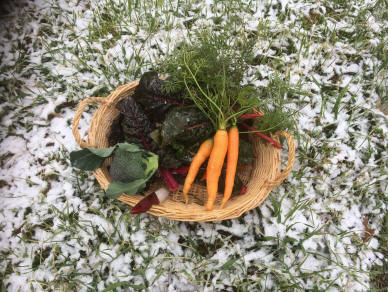 (8/17) I don’t know about you, but I’m getting tired of summer. I’m certainly not tired of luscious tomatoes and sweet corn, just the heat and humidity. I’m thinking about fall and the fall garden. I might even be a little late.
(8/17) I don’t know about you, but I’m getting tired of summer. I’m certainly not tired of luscious tomatoes and sweet corn, just the heat and humidity. I’m thinking about fall and the fall garden. I might even be a little late.
Some folks refer to the fall garden as the second spring, but that is only partially true. While cooler weather is always in the back of my mind as fall approaches, fall gardening is more constrained by the decreasing amount of daylight. I’m cleaning up the tired parts of the garden, and I’m still taking care of the squashes, pumpkins and sweet
potatoes, but I’m also preparing beds for fall crops. Several vegetables can be planted and harvested in the fall, and some crops can be planted in the fall to overwinter for an early spring treat – spinach and kale, for instance. Shallots and garlic are planted in the fall for harvest the following summer.
Which fall crops that usually give me the best results?
Greens: fast maturing lettuces (red-leaved varieties stand up to the cold better), kale (cold-sounding names like Siberian and Red Russian are good picks), spinach (Bloomsdale Long-standing or another of the hardy ones), collards and mustards, and Swiss chard.
Roots: carrots, beets, turnips, rutabagas, kohlrabi and radishes. Add parsnips if I had put them in by July 4th. Except for the radishes, these vegetables take on a sweeter taste after being nipped by frost.
Broccoli and Brussel sprouts are tricky if the weather is hot and dry, and they should be in the ground by now. A complete list, along with planting times for our location, zone 6b, is found at www.southernexposure.com/growing-guides/fall-winter-quick-guide.pdf
There are other differences between gardening in the spring and the fall. You need to allow more time until harvest than the seed package suggests. The plants take longer to mature in the fall than in the summer because of the decreasing daylight.
There are a few tricks you can try to insure your success. Pick a cool day to plant if you can. And remember that the soil temperature can be warmer than the air temperature, especially after a stretch of hot weather. A soil thermometer is a useful addition to your garden tool kit.
Some seeds don’t like to geminate in hot soil. Several seed catalogs and seed packets list the temperature range for best germination, but that range tends to be misleading. Beets, for example have a germination temperature range of 50–75oF. As the temperature approaches the upper portion of the specified range, the portion of seeds that germinate
drops off. While almost all the seeds sprout at the lower end of the temperature range, fewer 50% may germinate at the upper range.
Plant twice as many seeds as you would if you were planting in April, and thin them if necessary. You can add them to your salad; many of these cool weather vegetables are included in those expensive bags of microgreens you get at the grocery store.
Some seeds benefit from soaking in cool water before planting in hot weather, though trying to sow the damp, clumping seeds is tricky. As mentioned earlier, planting the seeds a little denser than normal isn’t a bad idea if you thin the seedlings before they start competing for light, water and nutrients.
Sow the seeds a little deeper than you would in the spring, but not too deep since those first seed leaves need to reach the light to make the food necessary for the young seedling. And tamp down the soil over the seed when it’s planted. This helps the emerging root make contact with the soil particles immediately. It also makes the soil
environment near the seed a bit cooler and holds the moisture a little longer.
Water frequently, twice a day if necessary. Putting a light layer of straw or loose, dry grass clippings over your seed bed helps retain moisture and keep soil cool. You cannot let the seeds dry out while they are trying to push their young roots out into the soil. Once an emerging seedling dries out, it won’t revive.
Provide shade. Row cover, that filmy cloth used to protect crops from devouring insects, can provide some shade and hold moisture, too. You can also plant the fall crops in the shade of summer crops. Peppers or tomatoes can become ‘nurse plants’ to your fall veggies. Be careful of the distance from your shade-providing vegetables, though. Keep in
mind you will likely be removing your tomatoes before your fall crops and you don’t want to disturb them.
Keep that row cover handy as the first frost date rolls around in October. The row cover becomes a light blanket that can help some of your more sensitive plants through the first few frosts. While these covers can protect plants down to 28o in most cases, they will not protect your plants from a hard freeze
If you have seeds left from last spring, give fall gardening a try. You can start small, perhaps a few greens to see you through the frost and a couple of weeks beyond that. You can even sneak a little lettuce or spinach into a flower bed. The reward is as sweet as a frost-nipped carrot.
Read other articles on plants and gardens
Read other fall related gardening articles
Read other articles by Debby Luquette